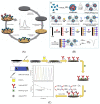Recent Progress in Electrochemical Immunosensors
- PMID: 34677316
- PMCID: PMC8533705
- DOI: 10.3390/bios11100360
Recent Progress in Electrochemical Immunosensors
Abstract
Biosensors used for medical diagnosis work by analyzing physiological fluids. Antibodies have been frequently used as molecular recognition molecules for the specific binding of target analytes from complex biological solutions. Electrochemistry has been introduced for the measurement of quantitative signals from transducer-bound analytes for many reasons, including good sensitivity. Recently, numerous electrochemical immunosensors have been developed and various strategies have been proposed to detect biomarkers. In this paper, the recent progress in electrochemical immunosensors is reviewed. In particular, we focused on the immobilization methods using antibodies for voltammetric, amperometric, impedimetric, and electrochemiluminescent immunosensors.
Keywords: amperometric immunosensors; biosensors; electrochemical immunosensors; eletrochemiluminescent immunosensors; immunosensors; impedimetric immunosensors; voltammetric immunosensors.
Conflict of interest statement
The authors declare no conflict of interest.
Figures









Similar articles
-
Electrochemical immunosensors - A powerful tool for analytical applications.Biosens Bioelectron. 2018 Apr 15;102:470-478. doi: 10.1016/j.bios.2017.11.029. Epub 2017 Nov 8. Biosens Bioelectron. 2018. PMID: 29182930 Review.
-
Advances in electrochemical immunosensors.Adv Clin Chem. 2019;92:1-57. doi: 10.1016/bs.acc.2019.04.006. Epub 2019 May 29. Adv Clin Chem. 2019. PMID: 31472751 Review.
-
The Role of Electrochemical Immunosensors in Clinical Analysis.Biosensors (Basel). 2019 Jul 9;9(3):86. doi: 10.3390/bios9030086. Biosensors (Basel). 2019. PMID: 31324020 Free PMC article. Review.
-
Recent Advances in Electrochemical Immunosensors with Nanomaterial Assistance for Signal Amplification.Biosensors (Basel). 2023 Jan 11;13(1):125. doi: 10.3390/bios13010125. Biosensors (Basel). 2023. PMID: 36671960 Free PMC article. Review.
-
Electrochemical immunosensors for Salmonella detection in food.Appl Microbiol Biotechnol. 2016 Jun;100(12):5301-12. doi: 10.1007/s00253-016-7548-y. Epub 2016 May 2. Appl Microbiol Biotechnol. 2016. PMID: 27138197 Review.
Cited by
-
Development of Folate-Group Impedimetric Biosensor Based on Polypyrrole Nanotubes Decorated with Gold Nanoparticles.Biosensors (Basel). 2022 Nov 4;12(11):970. doi: 10.3390/bios12110970. Biosensors (Basel). 2022. PMID: 36354479 Free PMC article.
-
A Novel Strategy for Selective Thyroid Hormone Determination Based on an Electrochemical Biosensor with Graphene Nanocomposite.Sensors (Basel). 2023 Jan 5;23(2):602. doi: 10.3390/s23020602. Sensors (Basel). 2023. PMID: 36679398 Free PMC article.
-
Microbial Fuel Cell-Based Organic Matter Sensors: Principles, Structures and Applications.Bioengineering (Basel). 2023 Jul 26;10(8):886. doi: 10.3390/bioengineering10080886. Bioengineering (Basel). 2023. PMID: 37627771 Free PMC article. Review.
-
Innovations and Challenges in Electroanalytical Tools for Rapid Biosurveillance of SARS-CoV-2.Adv Mater Technol. 2022 Jun 23:2200208. doi: 10.1002/admt.202200208. Online ahead of print. Adv Mater Technol. 2022. PMID: 35942251 Free PMC article.
-
Smartphone-Based Multiplexed Biosensing Tools for Health Monitoring.Biosensors (Basel). 2022 Jul 29;12(8):583. doi: 10.3390/bios12080583. Biosensors (Basel). 2022. PMID: 36004979 Free PMC article. Review.
References
-
- Park M., Heo Y.J. Biosensing technologies for chronic diseases. BioChip J. 2021;15:1–13. doi: 10.1007/s13206-021-00014-3. - DOI
-
- Park M. Orientation control of the molecular recognition layer for improved sensitivity: A review. BioChip J. 2019;13:82–94. doi: 10.1007/s13206-019-3103-0. - DOI
-
- Tu J., Torrente-Rodríguez R.M., Wang M., Gao W. The era of digital health: A review of portable and wearable affinity biosensors. Adv. Funct. Mater. 2020;30:1906713. doi: 10.1002/adfm.201906713. - DOI
-
- Liu D., Wang J., Wu L., Huang Y., Zhang Y., Zhu M., Wang Y., Zhu Z., Yang C. Trends in miniaturized biosensors for point-of-care testing. TrAC Trends Anal. Chem. 2020;122:115701. doi: 10.1016/j.trac.2019.115701. - DOI
Publication types
MeSH terms
Substances
Grants and funding
LinkOut - more resources
Full Text Sources

